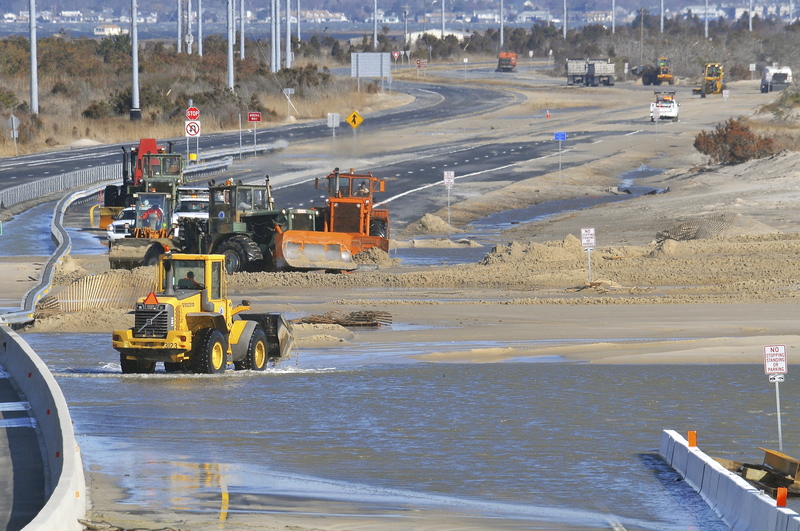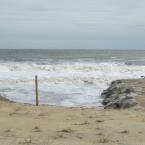Storm again closes IR bridge
For the second time in about four months, storm-driven flooding on Route 1 resulted in closure of the Indian River Inlet bridge. Route 1 was closed from Dewey Beach to Bethany Beach.
A powerful nor'easter breached the duneline just north of the bridge, forcing state transportation officials to close the bridge around 2:30 p.m. March 6. Crews were in place early the following morning to remove sand about 2 feet deep from northbound Route 1 lanes.
Standing water rising from Rehoboth Bay made travel impossible on the southbound lanes. During a March 7 press conference on the bridge, Delaware Department of Transportation Secretary Shailen Bhatt said the water should recede and southbound lanes were expected to be open by late afternoon. More work would be required on the northbound lanes with a projected opening of no later than Friday morning, Bhatt said. Details will be posted at deldot.gov.
Phase I of work to complete a 1,000 buried steel wall along Route 1 north of the bridge had been completed last week, Bhatt said. The wall, buried 40 feet in the sand, is designed to protect the roadway foundation during storms. “Water over the road is OK, but not under the road,” Bhatt said.
Bhatt said the nor'easter did not leave as big a footprint as Hurricane Sandy. As the hurricane churned off the coast, tidal surge and high waves pushed sand and water across all four lanes of Route 1, forcing officials to close the bridge for nearly a week. The secretary said the nor'easter deposited about two feet of sand on sections of the road where Sandy left about six feet of sand.
As officials debate what can be done to protect Route 1 from future storms, Bhatt said one thing is sure. “There will be more storms and with the awesome power of the ocean there is only so much we can do,” he said. “What we can do right now is recover as soon as we can.”
The $150 million bridge has been open for just over a year.
Bhatt said DelDOT, Department of Natural Resources and Environmental Control and U.S. Army Corps of Engineers officials are talking about options – including beach replenishment and a permanent sea-wall structure – to protect the road and bridge. “The beach has to be preserved, the road has to be preserved and the bridge has to be protected,” he said.
Bay towns cut off from mainland
Residents of Primehook Beach and Broadkill Beach who didn't evacuate in advance of the March 6 nor'easter were trapped with no access to the mainland. In advance of the storm, residents had been warned by state officials to leave the communities.
The two roads leading to the Delaware Bay communities – Prime Hook Road and Broadkill Road – were flooded by saturated marsh water around mid-day as rain, high wind and high tides pummeled the coast. The highest wind gust of 71 mph was recorded in nearby Lewes. Sustained winds of 35 mph to 45 mph pounded the area for nearly 24 hours.
As of mid-day March 7, both roads were closed, although water had receded enough on Broadkill Road for some vehicles to pass. “But at their own peril if they wanted to drive through saltwater,” said Jim Bailey, president of the Broadkill Beach Preservation Association.
To the north in Primehook Beach, residents who remained behind were cut off when flooding closed the main access to their community, as well as the secondary access on North Bay Shore Drive, a private road.
Bailey said flooding in Broadkill Beach was far less serious than flooding about four months ago during Hurricane Sandy.
Even so, wind-driven water cut off access to the communities. “If you didn't get out by 3 p.m. you were here for the duration,” Bailey said.
Bailey said residents are not left alone and are in contact with Sussex County Emergency Operations staff. “The EOC is a class act,” Bailey said. “They give us a lot of good advice.”
Prime Hook Road will remain closed until flood waters recede and transportation officials can determine if any damage was done, said DelDOT spokesman Jim Westhoff. Over the past three years, the road has been repaired at least twice following storms.
No reports of significant damage
Sussex County officials said there were no reports of significant property damage, and there were no requests for rescues from homes or businesses due to the nor'easter. Most areas of the county prone to flooding were inundated early on during the storm.
No evacuations were ordered and no shelters were established, said Chip Guy, the county's director of communications. “Residents either relocated voluntarily or homes in flood-prone areas were vacant because of the off-season timing of the storm,” Guy said.
The National Weather Service predicts that tides along the coast could remain high above normal into the weekend as the counter-clockwise flow around the storm will continue to push water into the shoreline along the Delaware Bay and Inland Bays, the areas that received the most flooding. However, weekend temperatures are expected to climb into the 50s.
At the height of the storm in Sussex County 5,200 Delmarva Power customers were without power; all but nine had been restored by 3 p.m., and they were expected to have power by 5 p.m. About 5,100 Delaware Electric Cooperative customers were also without power at the height of the storm, but by 7 a.m. March 7, all had been restored.













































































